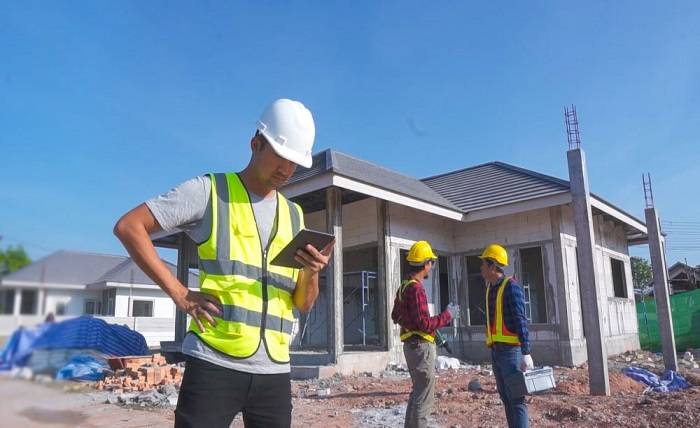Building your dream home is exciting, but it takes more than just a good floor plan and Pinterest board to bring it to life. Behind every well-built house is a reliable team of professionals working together to make the vision real. From the structure to the finishing touches, each expert plays a crucial role in ensuring everything is up to code, on budget, and exactly how you imagined.
While it’s tempting to think you can just hire a general contractor and call it a day, assembling the right team early on can save you time, stress, and unexpected costs down the road. Here are the key pros you’ll want on your home-building team—and why each one matters.
Architect: Turning Your Ideas Into a Blueprint
An architect is often the first pro you’ll meet when planning your custom home. Their role is more than just drawing up a layout—they’re there to help you visualize how your daily life will fit into a space. From making the most of natural light to creating flow between rooms, a skilled architect balances your style preferences with functionality and safety. They also ensure your plans comply with local building codes and zoning laws.
Whether you’re dreaming of a modern minimalist home or a cozy craftsman-style build, the architect helps translate your ideas into workable plans. They often collaborate with structural engineers and builders, so hiring someone who communicates well is key. Remember, this is someone you’ll be working closely with, so make sure you choose someone who listens and understands your vision. Good architects don’t just create beautiful designs—they create homes that make sense for your lifestyle.
Builder or General Contractor: The Project Manager on the Ground
Once the designs are ready, it’s the general contractor or builder who brings the plan to life. This person is responsible for coordinating all the moving parts—scheduling, sourcing materials, managing subcontractors, and overseeing construction. They are your main point of contact throughout the building process, and having a reliable one can make or break your experience.
A good contractor is organized, communicative, and experienced in residential construction. They know how to troubleshoot issues that pop up during the build and keep everything moving forward. Since they often hire the tradespeople like plumbers, roofers, and framers, their professional network is a huge asset. Transparency is key here, especially when it comes to timelines and budgets. Don’t be afraid to ask for references or examples of past work to ensure you’re choosing someone with a strong reputation.
Residential Electrician: Powering Up Your Home Safely
A home isn’t truly functional without safe and efficient electrical work—and that’s where a residential electrician comes in. They’re responsible for providing electrical services from installing wiring, outlets, circuit breakers, lighting systems, and more. Beyond just putting in sockets where you want them, they make sure your home meets local electrical codes and energy efficiency standards. In short, they help power every part of your day-to-day life.
Involving an electrician early in the process allows you to plan better for your lifestyle. Want smart lighting? A dedicated outlet for your home office? They’ll help you think through how electricity will flow through your home. This is also where safety matters most—cutting corners with electrical work can lead to serious risks down the line. So even if it’s tempting to DIY a few things, it’s best to rely on a licensed professional.
Interior Designer: Making the Space Feel Like Home
Interior designers go beyond picking out furniture—they help create a home that reflects your personality and feels functional and inviting. Whether you’re going for a modern, rustic, or eclectic look, they guide you through decisions like color schemes, finishes, lighting, and space planning. Designers also work closely with architects and contractors to ensure that your aesthetic preferences are incorporated into the early stages of the build.
Bringing in an interior designer early helps prevent costly changes later. For example, if you want a statement light fixture above the dining table, a designer can make sure the electrician installs the junction box in the right spot from the start. They also know where to splurge and where to save, keeping your budget in check while still achieving a high-end feel. Think of them as the finishing touch that makes your house feel like home from day one.
Residential Painters: The Final Touch That Ties It All Together
Once the drywall is up and the floors are in, residential painters step in to bring personality and polish to your home. Painting might seem like the easiest job, but it’s often one of the most noticeable features when walking into a room. A good paint job creates cohesion, sets the tone for each space, and even influences how large or small a room feels. Plus, high-quality paint and proper application protect your walls from wear and moisture over time.
Residential painters understand all aspects of painting services, from surface prep, texture differences, and how to achieve clean, sharp lines. They’ll also help you choose the right types of paint—matte, eggshell, semi-gloss—depending on the room’s function. For instance, kitchens and bathrooms need paint that can withstand humidity and wipe-downs. A skilled team will finish the job quickly, efficiently, and with attention to detail, which makes all the difference when you’re moving into your dream space.
Final Thoughts
Building a custom home is one of the biggest projects you’ll ever take on, and having the right team makes all the difference. Every expert—from your architect to the residential painters—brings something essential to the table. Communication, trust, and professionalism are key across the board. It’s not just about building a structure; it’s about creating a space that fits your life, your family, and your future.
By assembling a thoughtful team of professionals—including a skilled residential electrician and painter—you’re setting your dream home up for lasting success.

